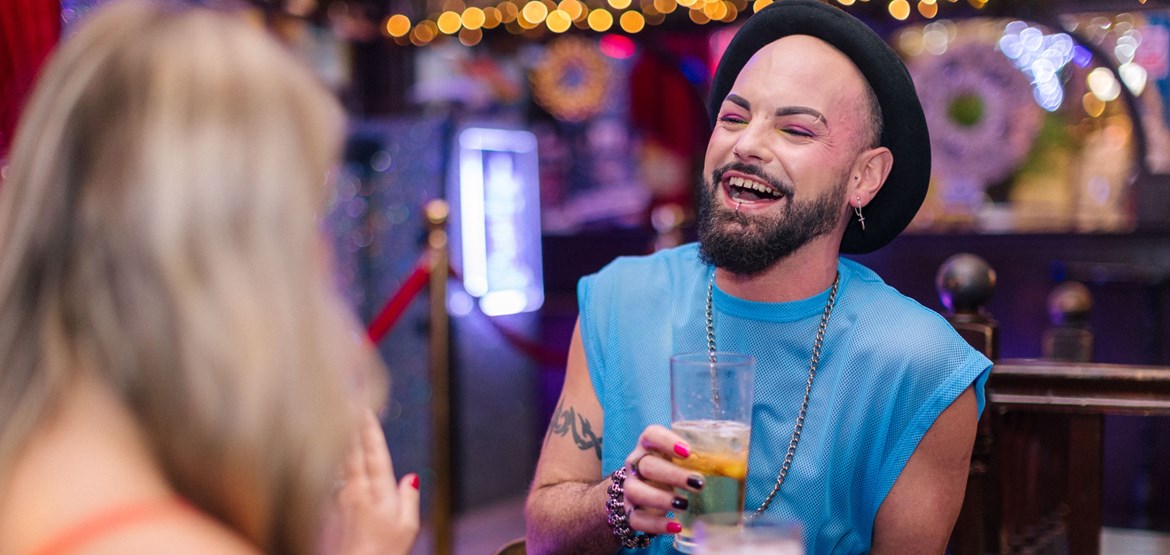A queer guide to navigating nightlife
Michael Handrick, author of Difference is Born on the Lips, discusses why the LGBTQ+ community has a particular need to understand how to have fun and stay safe.

Drinking spaces have historically been relative safe spaces for the LGBTQ+ to escape from the stigma and discrimination we face in society at large. While bars, clubs and bars continue to give us many nights of joy and community, it’s important to know how to enjoy yourself and stay safe on a night out. Binge drinking or drinking at high risk levels can result in becoming more vulnerable, the loss of inhibitions and control physically, emotionally and mentally.
Drink spiking in the LGBTQ+ community
Much of the media, reports, campaigns and public perception around drink spiking and assault are – importantly – focused on cis-heterosexual women. Reports show that up to 15% of women1 have been spiked with alcohol or drugs compared to 7% of men. However, what isn’t as widely talked about or reported on is that this is a big issue in the LGBTQ+ community. In a 2022 report, the Alcohol Education Trust recommended that more awareness be raised around drink spiking in the LGBTQ+ community where the prevalence of drink spiking was as high as it was among women.2
Alcohol, assault and sexual harassment
Statistics into sexual assault in bars towards LGBTQ+ people aren’t readily available, but one that sticks out is a report by SurvivorsUK that stated over a third of gay and bisexual men who experienced sexual assault said that it happened in a bar.3 It is imperative that wider research is done to understand how this affects the wider LGBTQ+ community - not just queer men - so more can be done to support the community as a whole.
These figures could be significantly higher within the community for a number of reasons. Growing up under Section 28, LGBTQ+ people were excluded from seeing reflections of themselves, learning about relationships, consent and safety in the context of being LGBTQ+. Many of us learned about, and found, our community out ‘on the scene’. For some, excessive drinking, unwanted attention and assault were normalised as a result due to the vacuum of representation, education and support we grew up in. Many are scared to report what they have experienced due to institutionalised queerphobia, the fear of not being believed, or even because it may mean ‘outing’ themselves. Myths and misconceptions can build up too around what a victim can and should look like that can result in a lack of understanding that it can happen to you.
Socialising is one of life’s greatest pleasures but it’s also vital that all communities are aware of how to stay safe at night.
What is drink spiking?
Different types of spiking can include the following substances being added to drinks:
- Alcohol
- Illegal drugs
- Prescription drugs (e.g. stimulants, tranquilisers, sedatives, opiates)
What are the symptoms of drink spiking?
Your symptoms could include:
- Lowered inhibitions
- Loss of balance
- Unsteadiness
- Feeling sleepy
- Visual problems
- Difficulty speaking
- Confusion
- Nausea
- Vomiting
- Unconsciousness
What is harassment in this context?
- Unwanted touching or groping
- Verbal abuse
- Persistent pestering
- Taking photographs without permission
- Unwanted attempts to kiss someone
- Staring or leering
- Following a person around, or refusing to leave them alone
- People exposing themselves publicly
How to stay safe on a night out
No one wants to go on a night out in fear or worrying about what may happen, but it’s pertinent to be careful and aware while out. Here are some quick tips to help stay safe:
- Don’t go out by yourself
- Let people know where you are
- Don’t leave friends behind
- Don’t leave drinks unattended
- Don’t accept drinks from strangers
- Support your friends or loved ones if they look like they’re displaying symptoms of spiking
There are simple, quick things you can do to stay safe when you go out – and they will reduce your risk of other alcohol-related harm like accidents too. For example, not ‘pre-loading’ with alcohol before going out, alternating between alcohol and water or other non-alcoholic drinks, sticking with friends, and having a nominated non-drinking driver.
What can be done?
All venues that are licensed to sell alcohol have a legal duty for public safety and the prevention of crime and disorder on their premises. It’s vital that venues continue to engage and train their staff to be aware of spiking and harassment as well as giving relevant training around the LGBTQ+ community, their needs and how best to support them in drinking venues. Simple measures like offering free drink stoppers and carrying out awareness campaigns to help the community understand the symptoms of drink spiking and what constitutes harassment or assault can have a positive impact.
There are a number of spaces and groups that decentralise socialising with alcohol within queer communities. Promoting alternative ways to interact, find and socialise beyond the ‘scene’ where alcohol has played a dominant role for decades is important. LGBTQ+ Community Centre, Queers Without Beers, Gay and Sober and Sappho Events all offer LGBTQ+ multidisciplinary events, socialising, and community without alcohol.
These issues are serious and it’s important that all sectors of our society receive the support they need. If you, or someone you know, have been affected by crime, including sexual harassment or any sort of sexual harm, help and support is available. Victim Support, an independent charity for victims and witnesses of crime, offer free, confidential help to anyone who’s been affected by sexual harassment. Call 08081689 111 or go to Victim Support's website.
Michael Handrick is the author of Difference is Born on the Lips and Head of Digital Product at Drinkaware.
Share your story
Sharing your story could help inspire others to make a change, so why not be an inspiration today. We'd love to hear from you!